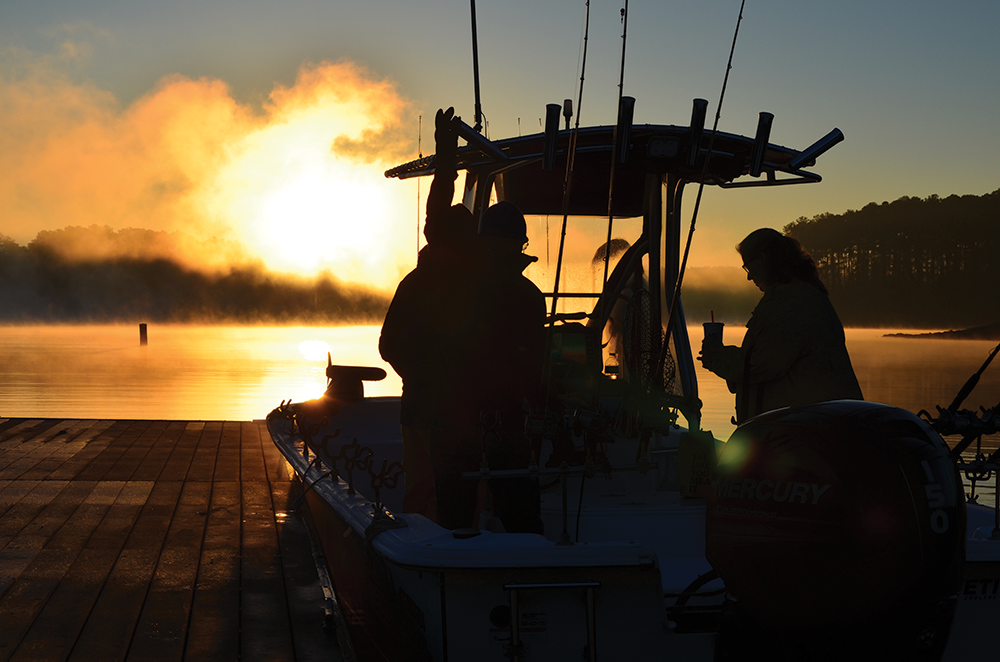Lighted docks can create great action at night

By John N. Felsher
During summer swelter, armadas of jet skis, boats and other recreational craft churn the waters of practically every lake in Alabama during daylight hours. To escape whirling propellers, fish might go into a kind of shock. They drop into deep holes and come down with a severe case of piscatorial lockjaw.
At night, however, fewer anglers and almost no recreational boaters venture out. In the cool, quiet of the evening, giant bass lose some of their wariness and start feeding more aggressively.
Many property owners install lights that shine over the water at the ends of their docks. Light gathers plankton. Plankton attracts shad, minnows and other small creatures. In addition, lights attract insects. Inevitably, some bugs fall into the water where fish devour them. Largemouths, hybrid striped bass, white bass, crappie and other predators gather in lighted areas to eat the small fish.
“Lights kickstart the whole food chain,” says David Pair, a fisherman from Abbeville. “Bass are more nocturnal by nature anyway. Those lights always have minnows, shad or some other kind of small fish around them.”
Pair frequently fishes Lake Eufaula. Often called the “Bass Fishing Capital of the World,” but officially dubbed Walter F. George Reservoir, the impoundment covers 45,181 acres along the Chattahoochee River spanning part of the Alabama-Georgia border. For decades, Lake Eufaula produced uncountable numbers of one-to four-pound bass, many in the five-to eight-pound range and some bigger ones. A few top 12 pounds.
“Lake Eufaula is well known for producing big bass and big stringers of bass,” says Jack Tibbs, mayor of the town of Eufaula and owner of Strikezone Lures. “Sometimes, it takes more than 26 pounds with five fish to win a tournament.”
Most nocturnal anglers naturally gravitate toward docks with lights hanging over the water. Those highly visible lights can produce excellent action, but anyone can spot them from miles away. Anglers can’t spot underwater lights as easily, but fish find them with no problem. Since fewer people can locate underwater lights, they don’t attract as much fishing pressure. During the daylight, nobody even knows those lights exist unless someone snags one.
“Sometimes, I fish lights hanging over the water, especially if they are down close to the surface, but I usually prefer to fish underwater lights,” Pair says. “I do fish one overhead light where we sometimes catch fish on every cast for 10 to 15 minutes. One time, I might catch all two- to five-pound hybrids. The next time, I might catch all five-pound largemouths.”
Lights shining on the surface from above don’t penetrate the water as deeply. They also create glare on the water. In addition, overhead lights attract more bugs, the bane of all nocturnal fishermen. Underwater lights don’t attract nearly as many mosquitoes.
“Underwater lights are sealed, weighted on the bottom and shining upward toward the surface,” says Pair, who not only fishes around underwater lights, but sells them. “Most underwater lights are green, but some are white. With the lights shining upward, bass and other fish can see their prey a little better. People can watch the water and see a lot of fish activity around the lights.”
Since largemouth bass and hybrids routinely feed upon shad, any lures that resemble baitfish should work around the lights for either species. Crankbaits closely resemble shad or other baitfish. Use lures in white, pearl or similar colors to mimic threadfin shad. Throw crankbaits that run five to 10 feet deep, depending upon the water depth. Some soft-plastic baits, such as swimbaits or fluke-type lures, or topwaters can also work when bass attack shad.
“When I want to catch big bass, I look for shad about the size of my hand swimming around the lights,” Pair says. “A girl fishing with me one night caught a bass weighing 11.25 pounds. We lost some fish that made that one look small. I’ve caught numerous 10-pounders and even some nine-pounders on back-to-back casts by the lights.”
When specifically fishing for white or hybrid bass, move lures a little faster. For largemouths, fish baits more erratically. Concentrate on the transition zone where light fades to darkness. Predators frequently lurk in the shadows, dashing out to snatch anything tempting they see in the light.
What works at Lake Eufaula could also work around any docks, boathouses, industrial wharfs, bridges or similar places with either overhead or underwater illumination. Look for flashing baitfish about around glowing orbs.




